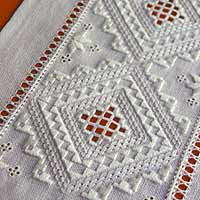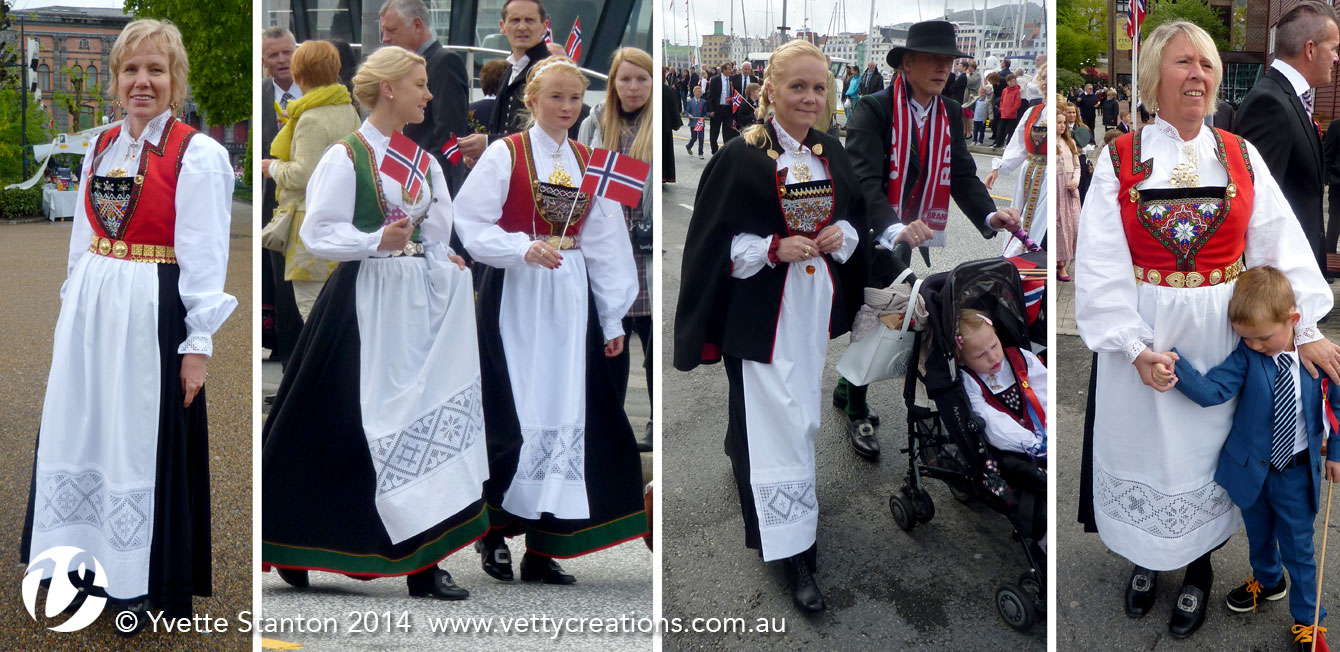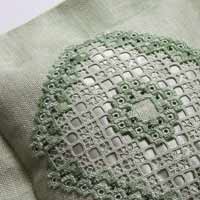What is Hardanger embroidery?

|
|
Hardangersøm (or Hardangersaum), is Norwegian for 'embroidery from Hardanger', and refers to the style of needlework that many of us know as Hardanger embroidery.
Hardanger embroidery is a style of cutwork embroidery that originates from the Hardangerfjord region of Norway, in Hordaland county. It was traditionally worked on the clothing of the area, which over time has developed into the regional costumes now known as bunad. Within the region there are many different styles of bunad, each with their own style, but many from this region feature Hardanger embroidery. Usually the embroidery is found on the apron, and on the cuffs, collar and front yoke of the women's blouses.
Traditionally, Hardanger involves white embroidery on white fabric, where the removal of some of the fabric's threads produce a lacy effect. It is a counted embroidery, meaning that the position of the stitches is determined by counting the threads of the fabric.
|


Bunads from the Hardanger region of Norway.
Traditional Hardanger embroidery
Hardanger was originally worked in bands of embroidery across items such as aprons, shirts, and household linen. It often featured:
- diamond, triangular or square motifs of cutwork
- satin stitching in rectangular blocks (kloster blocks) and other shapes
- pulled thread work in the form of four-sided stitch
- cable stitch
- eyelets
- borders of needleweaving and four-sided stitch along each long side of the embroidery (which were usually the top and bottom).
Within the parameters described above, there was a huge amount of room for creativity in design of Hardanger needlework patterns. The designs are hugely varied, and very beautiful. The filling stitches used in the cutwork were still very simple - often just knotted picots,or diagonal twisted bars, or none!
Hardangersøm was worked in white linen thread on white linen fabric (or cream on cream) of a single weave i.e. not the double or basket weave of contemporary "Hardanger" fabric.
The earliest surviving pieces of Hardanger date from the eighteenth century. It is possible that this style of embroidery was first developed to imitate the Italian needle laces known as punto in aria, reticella, and similar styles of work. However because the Hardanger region is geographically isolated, due to the fjords found there, the style of embroidery developed and became quite distinct.
Contemporary Hardanger embroidery
Contemporary designs are very different to traditional Hardanger needlework patterns. In the last century or so, many changes have occurred in the way Hardanger pieces are designed and worked. Coloured and novelty threads and coloured fabrics are now commonly used. New stitches have been developed, including buttonholed edges. Hardanger sometimes is worked together with other techniques such as cross stitch.
The buttonhole edge so common in contemporary Hardanger did not develop until much later. It is one of the main things that has changed hardanger so much. According to information collected by Lucy Lyons Willis, traditional Hardanger embroidery designs never used a stitch like this because it would have used up too much precious thread. The buttonhole edge means that Hardanger pieces can now be practically any shape you desire! |
|

Hardanger embroidery cushion in soft greens with silk and beads designed by Yvette Stanton
|
Learning Hardanger embroidery
Yvette Stanton provides the following methods for learning Hardanger embroidery.
|
|
NOW AVAILABLE!

Purchase your copy of Yvette Stanton's latest book today!

Purchase your copy today!
Elegant Hardanger Embroidery
I am really impressed with it. I knew there must be more to Hardanger than the simple Kloster blocks you see demonstrated on the web. I feel quite confident now to try a project, and I’m hoping I won’t need to refer back to your section on fixing mistakes!

Purchase your copy today!
Your writing style and illustrations finally made everything come into focus and showed me that I don’t have to feel like I am all thumbs when I am doing hardanger. This book will be my constant companion for at least the next two project and treasured reference thereafter.
An excellent book for everyone wanting to learn Hardanger. Also has tips to help the more expert …the projects are lovely, filling half of the 62 page book. I’m preparing to start two of them which is an indication of value of owning the book. There are some helpful sections when you have made mistakes with cutting and information about caring for your finished work, often not included with the instructions for the stitching. --JL
|









